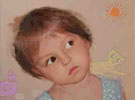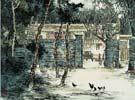Salve Regina Souvenir
Beatriz Millar
Salve Regina Souvenir by Beatriz Millar continues the artist's conceptual exploration of various forms of protest and spirituality using a multimedia language consisting of performance, photography, sculpture and video, weaving together the personal origins of the artist. There are numerous references to previous series of the artist's work, the first being the theme of femaleness. Since the beginning of the nineties, in stylistically taking on Futurism, the artist criticizes certain male attitudes that reduce women to mere unbridled objects of sexual gratification. To support these works, published in the catalogue edited by Romana Loda in 1999, Beatriz Millar often adds comments such as "I, who always wanted to be holier than the others" in La macchina bianca (The white car), or "Uomo sei (You are man).Donne siamo (We are women). Sei seduto comodo! (Are you sitting comfortably!)," in Decisione (Decision), both from 1991. In these paintings, and then in the works on wood, the figure of the woman oscillates between an abused exterior image and deep individual spirituality, sometimes summed up in the romantic reconciliation between man and woman in the Tango series, whose perfect harmony however, makes one think of a more idealistic or ironic rather than objective vision.
In those same years, another source of inspiration and analysis can be seen in the very titles of her paintings: San Francis Song from 1993, where she comments "I wonder if my song of the sun reaches its destination" or Agnus Dei and Himmelskönigin (Queen of Heaven), on which, in particular, Millar adds: "On soft hills she counts the stars and greets the angels. Mother of the earth that protects and supports, the queen of heaven."
Around the same time, the artist dedicated a series of paintings to the automobile, called the Carro (Chariot), which recalls another aspect of the Futurist style, but with the internal parts surrounded by angels. Another recurring theme is TV, screens and ready-made painted canvasses, referring to media communication, cancelled out and sublimated here by a painting style that anthropomorphizes structural forms. The artist's need to take on social and cultural tendencies to criticize them, leads to a spiritual attitude that seems to be expressed in the artistic rather than the strictly religious idiom. In Salve Regina Souvenir , the artist draws on performance, something she had worked with in the past, insisting on the fragmentary nature of the identities we are obliged to assume. The rebellious or ecstatic attitude she has had so far, became explicit in some text excerpts that appeared in the catalogue on her work, such as, on the one hand: "... I hating capitalists... I hating seduction ... I not being a product .. and on the other hand: "... I waiting ... I believing in God the Saviour ... I trying to be sorceress ... I looking for paradise ... I being part of the alchemy... I be Mother Dolores ... I be Mary Magdalene." The contradiction that often characterized the works of the Italian-Swiss artist is now surpassed in Salve Regina Souvenir by a ritual originally created to be shared with ordinary people, not strictly connected to the art world, where protest is sublimated through communion . The act of sharing a meal recalls the Last Supper of Christ and the bread, of which her sculptures are made, is the food of the poorest and at the same time, the most sacred.
The sickening mundane counterpart, symbolized, for example, by digital verbal-visual paintings from 2002, with representative flags and the faces of political leaders, with splashes of blood mixed with ironic messages, is the terrain Millar needs to be able to reach this new type of conclusion. The awakening of consciousness and the research surrounding identity in the mouth series, such as "Red Lips: I'm the Thought" from 2003, recalls a messianic and oracular function in art.
These edible sculptures, like Veneri Paleolitiche (Palaeolithic Venuses) with their large breasts and prominent bellies, fertility symbols, again represent in Millar's work the figure of the woman, here an archetypal mother, the holy woman, the souvenir of her power that, in the last instance of being consumed, may finally be internalized. On the other hand, the primitivism of these sculptures, whose appeal to the origins has attracted generations of artists from Picasso to Modigliani, in Millar's work is not only a formal style, but a possible way of life: the one that harks back to her peasant grandmother and baker father in Einsiedeln, among other things, and the place of pilgrimage dedicated to Switzerland's most important Virgin Mary.
For art as a process, a participatory sharing and encroachment into the mainstream of everyday life, Salve Regina Souvenir echoes the operations by Fluxus, currently contributing to relational art. But a number of other aspects, such as the centrality of nature, once again evident in her series of works on trees, Make Up the Tree from 2005, the need for a universal brotherhood, the tendency towards the mystic and the search for the latent capacities of man, can fully affiliate the art of Beatriz Millar with Madame Blavatsky's vision as expressed in Theosophy. Such theories, later elaborated upon by Rudolf Steiner in Anthroposophy, who established two centres in Switzerland, were also followed, not coincidentally, by Joseph Beuys himself.





